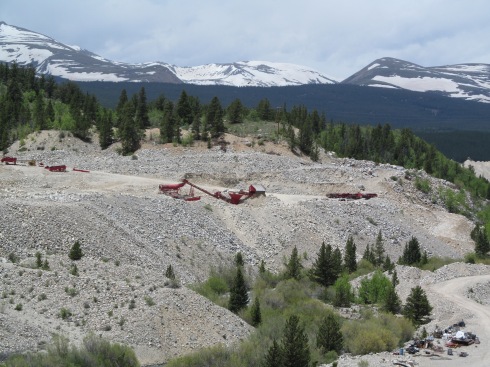You are currently browsing the category archive for the ‘Mining’ category.
Much has been written about the gas & oil industry in the US. My aim only is to highlight the leaking, not actively producing, oil & gas wells.
Many states have a problem with orphaned and zombie wells. Big ole Texas has a problem with orphaned and “zombie” oil wells also. Over time, oil and gas companies have been abandoning uncapped oil and gas wells in their eternal haste to produce “Black Gold, Texas Tea.” Inactive or non-compliant wells with delinquent organizational reports (Form P-5) for more than 12 months are called “orphan” wells in Texas. The state of Texas does have procedures for the disposition of orphan wells. Wells may be abandoned because of low output or the owners going bankrupt. It is possible to take over an orphaned well, though why would someone takeover a depleted orphan well or a low output well?
What’s worse, even the capped wells have begun to leak because of the corrosion and decay of well casings and plug material. The leak may be far down the hole or near the surface. These abandoned wells that are now leaking are called “zombie” wells. The zombie wells push up brackish water along with hydrocarbon liquids and vapors into the atmosphere and the surface soil as well as underground into the water table. Some underground flows are large enough that sinkholes form and fill up with polluted water.
The Oil & Gas division of the Texas Railroad Commission is responsible for “Regulating the exploration, production, & transportation of oil and natural gas in Texas.”
In a September 14, 2022, article in the Houston Chronicle, James Osborne writes
“After more than a century of oil drilling in Texas, the state is littered with abandoned wells, the vast majority of which were never properly plugged. No one’s entirely sure how many but the Texas Railroad Commission puts the number of inactive wells at almost 150,000, approximately 17,000 of which haven’t operated in more than 20 years, according to the activist group Commission Shift.“
Source: Houston Chronicle
Following up, Amanda Drane writes in her July 17, 2023, article in the Houston Chronicle
“The Railroad Commission plugged 1,068 wells during fiscal 2022 at a cost of $29.5 million, and added another 944 over the same period. During the second quarter, it said it plugged 363 wells at a cost of $11.7 million — 119 wells with state funds and 244 wells with money from the federal Infrastructure Investment and Jobs Act, which has promised Texas nearly $320 million in phased disbursements.”
Source: Houston Chronicle
The Texas Oil & Gas Association has stated-
“the oil and natural gas industry has paid hundreds of millions of dollars to have orphaned wells properly plugged… We welcome federal funding to enhance what industry has already contributed to address orphaned wells.”
Source: The Houston Chronicle.
As can be seen, the Texas Oil & Gas Association seems to feel that it has done its job with orphaned wells. The Teflon-coated Texas Oil & Gas trade association did what trade groups are supposed to do- shield their members from public blame and immense liability.
One component of crude oil & gas is hydrogen sulfide (H2S) which resides in both the liquid and vapor phases. This component is capable of both oxidation in the air to form a series of variously oxidized sulfur products as well as elemental sulfur itself. Hydrogen sulfide is extremely toxic and prone to cause olfactory fatigue in humans. The odor threshold is extremely low which could lead one to safely vacate the area, but the “nose numbing” effect on the sense of smell can lead to a false sense of security and continued exposure. Most cases of intoxication occur in confined spaces, however.
In a way, drilling for and striking oil & gas is like opening Pandora’s box. The well can produce valuable oil & gas, but along with it comes produced water with undesired dissolved minerals, petroleum and drilling residues. It seems clear that the State has a compelling interest in the final disposition of the well. The driller or party who owns the drilling rights to the well should be financially responsible for its clean shutdown. Bankruptcy should not absolve a company from responsibility for trouble the well brings.
Industry and people are like a gas- they expand to occupy the space available to them.
This post is limited to the issue in Texas but it can exist anywhere oil & gas drilling has occurred. Obviously, the oil & gas industry represents a massive amount of economic activity and consequently it has enjoyed a privileged position in American industry in terms of regulations. It is doubtful this will change but that doesn’t mean that the beady eye of scrutiny should blink.
Even if hydrocarbon vapors and other gaseous substances blowing out of wells were not greenhouse gases, can’t a case be made for capping-off wells just to prevent pollution? There is a mentality out there that holds that if some pollution action is not mandatory, then it is not necessary. Their response to a problem is often that they “met regulatory standards.” That is, they would have done less if they could have.

A Blacksmith shop is all that remains of Anaconda, Colorado.
The discovery of gold in the early 1890’s west of Pikes Peak at Cripple Creek was the last major gold rush in Colorado. This discovery coincided with the repeal of the Sherman Silver Act which compelled the government to guarantee a price for silver. The repeal of the Sherman Silver Act led to an immediate collapse in silver prices and the crash of virtually all silver mining operations. As a result, miners in the area made their way to Cripple Creek for newly discovered gold.
Today many of the valleys around Cripple Creek and Victor are largely regrown and quiet. Little indication remains of the towns and mills that once covered the area. Many mining towns were consumed by fire and a few were rebuilt. Once town left to extinction is Anaconda.
In the winter of 1904 a fire consumed the mining town of Anaconda. Today, all that remains is the shell of a blacksmith shop. This abandoned building sits at the end of the line on the Cripple Creek and Victor Narrow Gauge Railroad (CC&V). Near Anaconda were a number of significant mines- the Mary McKinney, the Doctor Jack Pot, the Chickenhawk, the Anaconda mine and others.
Nearby is the Mollie Kathleen mine which is open for tours. This tour involves piling into a small-man lift and dropping 1000 ft into the mine. This puts you below the level of Cripple Creek, located in the valley below. If you are very lucky, the big open pit gold mine on the other side of the mountain will do some bench blasting while you are down there. It’s very exciting. The mountain between the big CC&V mine and the Mollie Kathleen is riddled with shafts and drifts.
The Cripple Creek & Victor Gold Mine east of Cripple Creek is a large open pit gold mining operation run by Newmont Mining Corporation. The gold in the mine is highly disseminated in microscopic form and is recovered by cyanide heap extraction. The CC&V deposit is the remnant of an extinct volcano that is highly brecciated. Hydrothermal water has extracted and transported gold throughout the throat of the volcano and into the surrounding rock. However, much of the gold (ca 30 %) is tied up as gold telluride, AuTe2, also known as calaverite. The gold in calaverite cannot be extracted with cyanide and must be left behind. The tellurium can be removed by roasting and burning off the oxide, but this is highly polluting. This gold formation is where the famous Cresson Vug was located. It was a cavity in the formation that yielded 60,000 troy ounces of gold.

CC&V Steam Engine
The CC&V railroad is a modest tourist attraction located on the outskirts of Cripple Creek. The line has several operating steam locomotives that take passengers on a 45 minute trip into the countryside. Our engineer estimated the horsepower of the engine above to be ca 20 hp. Narrow gauge rail was popular in mountainous areas as opposed to standard gauge owing to the ability to negotiate a tighter turn radius.











Recent Comments